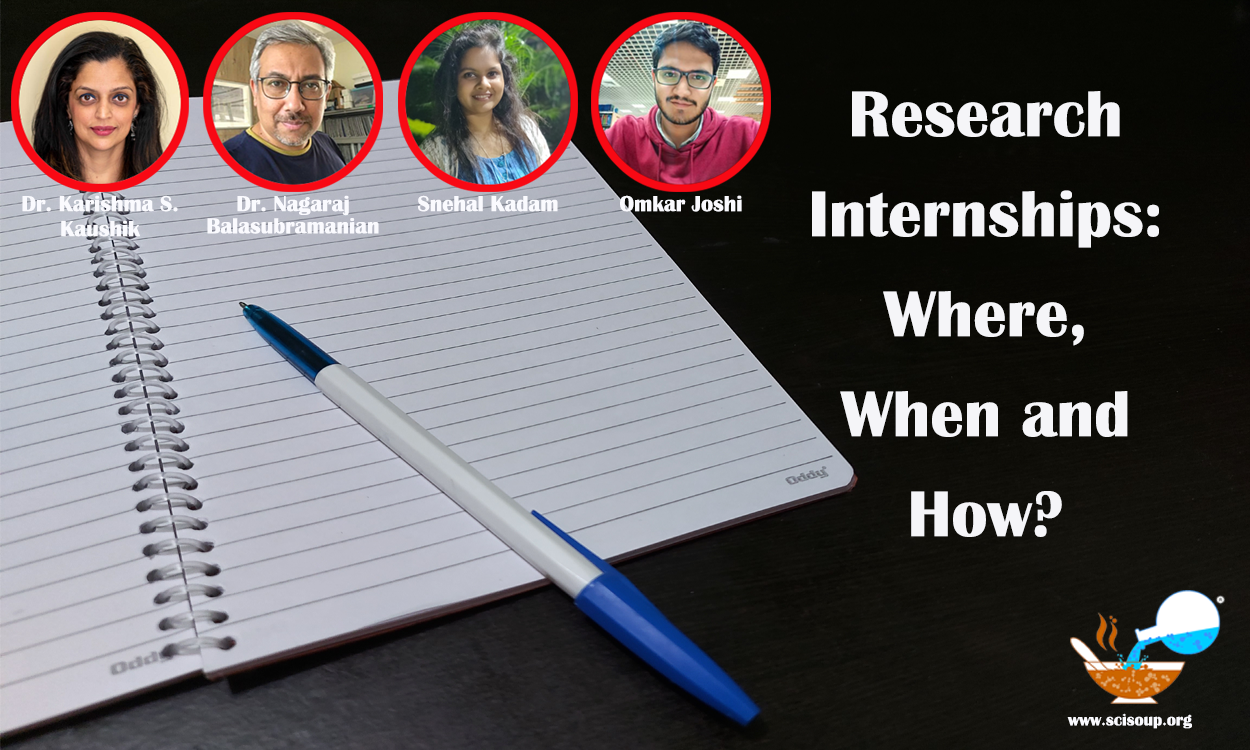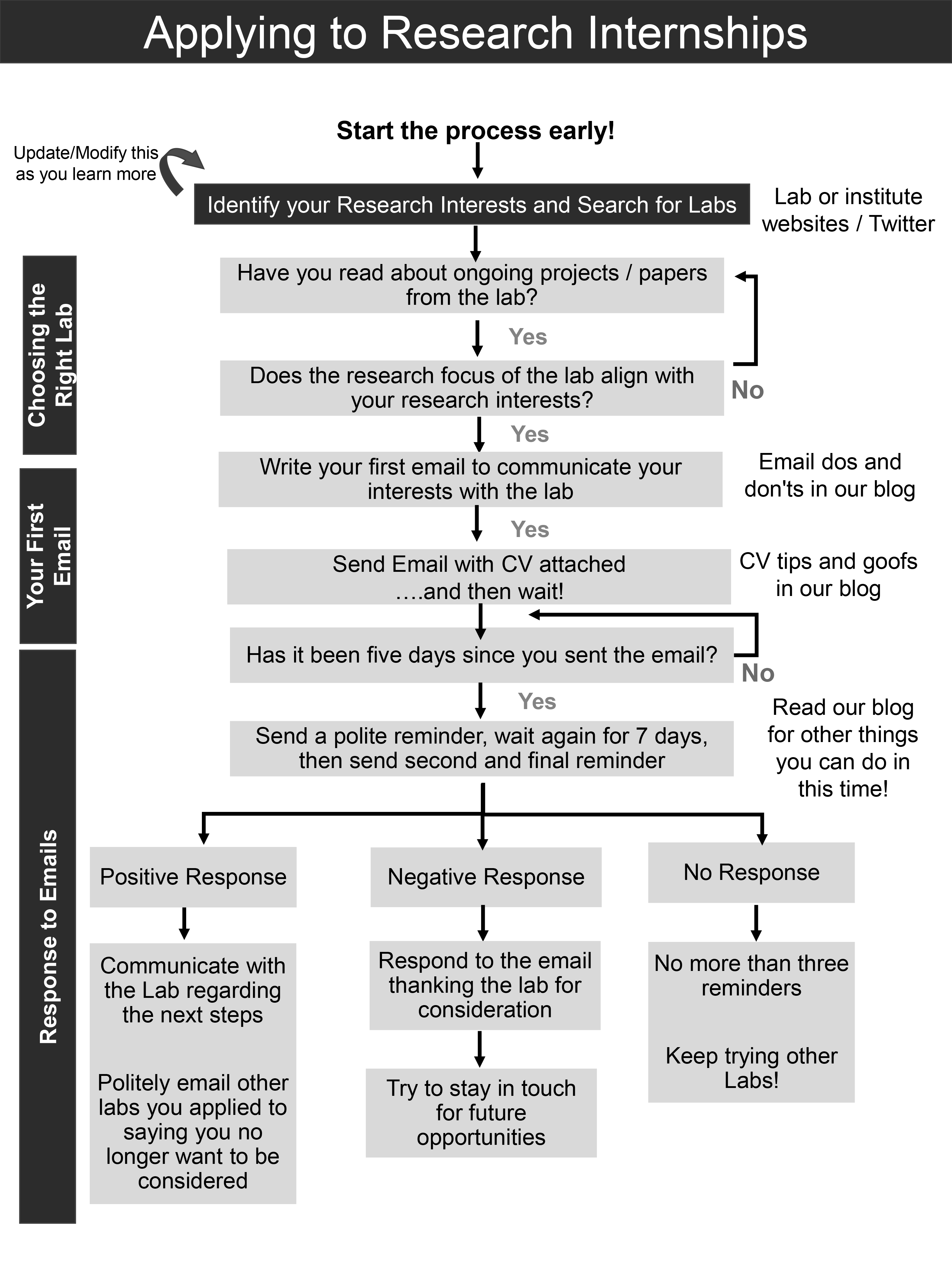
This blog includes different aspects of choosing the right lab, writing the first email, responding to emails and making a strong CV/Resume.
JUN 29, 2020 | BY KARISHMA S. KAUSHIK , NAGARAJ BALASUBRAMANIAN, SNEHAL KADAM, OMKAR JOSHI
In a webinar, four scientists got together to talk about the when, where and how of research internships. Given the unprecedented response of over 500 participants and a host of relevant questions, we have written the key aspects of the webinar discussion as a blog. We hope that this write-up serves as a resource for students of life science in India, looking to pursue research internships, and a ready-reckoner for times when young students are unsure or pondering along the process.
This blog includes different aspects of choosing the right lab, writing the first email, responding to emails and making a strong CV/Resume.
A full recording of this webinar and slides are available at https://www.karishmakaushiklab.com/beyond-the-bench
Click Here to Download PDF ( Webinar Slides)
Dr. Karishma S. Kaushik - Assistant Professor at the Institute of Bioinformatics and Biotechnology (IBB), Savitribai Phule Pune University (SPPU) Visit KaushikLab here
Dr. Nagaraj Balasubramanian- Associate Professor at the Indian Institute of Science Education and Research (IISER) Pune Visit Adhesionlab here
Snehal Kadam- Research assistant working with Dr. Karishma Kaushik
Omkar Joshi- Undergraduate student with Dr. Nagaraj Balasubramanian
 Finding a correct ‘niche’ lab structure for a valuable gain of experience
Finding a correct ‘niche’ lab structure for a valuable gain of experience
Choosing and applying to the right lab is, in a way, the platform on which you will construct your building. Choosing a lab which is relevant to you and sparks your interest is immensely vital for your performance in the lab. This decision is often challenging and requires introspection. Start by systematically writing down your priorities. This list may be multifactorial, considering not only the topic or area of interest but also the department and its location, publications from the lab and importantly the gender ratio. This list is unique to you and will reflect what matters to you. It should help you make an informed decision, and not just go by the reputation of the lab or the general application trends set by others.
One of the best ways to apply to any lab is to ‘pitch’ an idea. The idea may or may not be very novel or something you end up working on, but it showcases your homework and commitment to the lab. Even if you do not have a well fleshed-out and focused idea to pitch, make sure to highlight the area you would like to work in. To develop an idea it is key to read relevant material (visiting lab websites, recent publications). For this, it’s important to start the process well in advance, giving yourself enough time to identify and become familiar with your topic of interest. Always remember, you should aim to be relevant to the lab that is relevant to you!
Writing an email that gets you a desired reply
The next step is to write that first email! Remember, this is your first impression, so never do this when you are not in the right headspace - you will definitely make mistakes. Start by listing strengths about you - this email should convey.
When starting an email, it is best to address the Principal Investigator (PI) with their name and title (for example, Dr. XYZ) rather using terms such as ‘Respected Sir/Madam’. Using ‘Sir/Madam’ can be an instant bad turn, as many PIs will not even read the email further if you have not bothered finding out their name. If you are writing to multiple PIs in an institution, do write separate emails to each of them. Also, write the email only yourself and not for you and a friend. It is fine to take second opinion from others to ensure that there are no obvious mistakes.
A well-structured email has a higher chance of catching the PI’s attention (because it shows that you put in work to draft a good email). Start the email by introducing yourself, what you are currently doing and why you are writing this email. Then, go on to state your research interests, your educational background and relevant research experience if any. It’s always a good idea to tie in your research interests with some ongoing projects in the lab (which you have hopefully identified on their website or from their recent papers). In the last section of the email, tell the PI about time commitments (for example, ‘I am looking for an internship for 3 months from __ to __’) and any other information that will be relevant to your application. Sign off by showing enthusiasm and interest in hearing back from them. We recommend attaching your CV (see the section on making your CV).
Some important things to remember - do not write lengthy emails, be precise and focused (unclear and generic emails do not create good impressions), use grammar tools (Grammarly) to check your emails before sending them and finally, do not use fonts that are difficult to read or too fancy (stick to Arial, Times New Roman). Find an appropriate time to send the email - it should reach the PI between their working hours (remember to account for time zone differences if any).
How to follow up on your first email and the waiting period for email exchanges
After you have done all the hard work of writing the right email, it is now crucial for you to wait for a response. Don’t haste this process, and wait at least 5 days for a reply. These few days can be anxious and tough, so indulge yourself with other activities to take your mind off this topic. Don’t assume anything and focus on something else, maybe start working on your application for a different lab. The second email as a follow up must be sent. This serves as gentle reminder if you don’t hear back after ~5 days. It usually takes few such emails before you a get a desired reply. The mantra is to be consistent and persistent!
For multiple reasons, writing a polite reminder can be hugely beneficial for you and your application. Often, PIs may have genuinely forgotten to respond, maybe traveling, have not received the email (finicky web clients!), and would be happy to get that polite and timely reminder. Sending up to two reminders would mostly be acceptable.
Say you now get a response from the lab. If the lab accepts you, viola! Make the most of the opportunity; ask the lab what the project would entail and if there is anyone from the lab you can communicate with independent of the PI. Enquire about logistics like stay and travel once things are more final. When you have joined the lab, work hard and give it your best. Make a conscious effort to attend talks and seminars in the department you join, these can add a lot to what you gain. Do communicate with others in the lab and in the department in your time there, the networks you build could become useful going forward. If the lab does not have a position at present, don’t lose hope, respond to the email and do suggest your availability and interest if there is an opening available in the future. Maintaining communication with professors can be beneficial, and your application can be considered once an opening comes up if you keep yourself associated with the lab and their work. Politely asking about the timeline of any future openings, any specific reasons for the decline (if they haven't told you already) can help. Do not however get upset if you do not receive any further response to your queries from the lab.
In summary, be patient, let the PI approve, and then you can ask them detailed queries. Keep your eyes open to other opportunities and don’t shy away from approaching people whose work you find interesting.
Making your CV/Resume
The most important thing to remember when making your CV is to keep it short (2 pages). There are many examples of a model CV available online. Academic CVs generally follow chronological order (each section should depict the most recent information first). Provide your name and contact details (email ID, phone number) and leave out unnecessary information like your photo, home address, blood group, marital status (this information may be required for other paperwork like visa, but it is not important for the PI to select you).
Make sure you do add:
• Educational background (undergraduate onwards)
• Publications or Project Experience
• Workshops/Conferences/Seminars Attended
• Awards/Fellowships Received
• Outreach activities/blogs/features/scicomm
Modify your resume depending on the application - change the objective, details of research experience, chronology as per need. Use your extra-curricular activities - they can convey skills like teamwork, leadership, dedication - all important to research as well! Run your CV through grammar check software. Always send a PDF version of your CV (not Word documents as fonts and layouts can get easily messed up).
Feedback from Webinar Participants
Meetali Barhate (undergraduate student, IBB): “I always had a lot of questions about how I should apply for internships. I used to get very confused when choosing the labs that I can apply to. What to do when the lab does not respond was always the most difficult question I had in my mind. After attending the webinar, a lot of queries got cleared, like how to apply for an internship, how to choose the right lab, what are the things we are supposed to write, and what things we should avoid writing in the mail that we send to the lab. I found out that there were a lot of things that I was doing wrong when applying for internships. I am lucky to have got the opportunity to directly ask my doubts to scientists like Dr. Karishma Kaushik and Dr. Nagraj Balasubramanian. In the future, I would like to learn about the following things-
1. How many days prior should we apply for internships?
→ Usually, three months prior to the internship is a good time to apply. That said, if you think a lab is of a very high interest to you, you can apply even a year in advance (making sure you properly clarify your commitment dates)!
2. Should we apply only for the internships that are very specific to our research interests?
→ In order to make most of any internship opportunity, it is important that the work in the lab interests you. Even if not very specific, you should like the broad area of work in the lab. If you want to explore a new field, it will still be beneficial to familiarize yourself with the work by reading, talking to the PI or members of the lab.
3. Is it okay to ask for recommendation letters from labs that we have worked for 1-2 months?
If yes, what is the correct way to do so?
→ Yes, it is perfectly alright to ask for recommendation letters from such labs. In general, when asking for a recommendation letter, provide all the necessary details about the internship like the portal/program, the Institute and/or the lab that you are applying to. This will help your PI while writing the letter. If you think the letter should comment on any specific qualities, make sure to convey them to the PI. Request your PI for the letter at least two-weeks prior to the deadline, such that they have enough time to write it. In this particular case where you have worked in the lab for 1-2 months, don’t forget to introduce yourself and update the PI with your current academic and research status.
4. If you have some very specific and special extra-curricular activities, is it okay to mention it in
the email we write to the lab (even if it is mentioned in your CV)?
→ The email is primarily meant to highlight your background, research interest and relevance to the lab. If you think mentioning extra-curricular activities will help the cause, you can mention them briefly. But take care that it shouldn’t break the flow of the email and shouldn’t overshadow the other relevant points.
5. Information regarding writing SOP.”
→ The Statement of Purpose is used to expand on your CV, but convey information that is not available in the CV. This can be in terms of what are your research interests, what have you learnt from your previous research experiences, how does this tie into the program/project you are applying to and what makes you an excellent candidate for the project.
Anoushka Gholap (undergraduate student, IBB): “What I liked about the discussion was that the talk had good flow. The simple language throughout made it easy to understand. Majority of the questions from the participant's point of view were answered. The question of how to choose the right lab was satisfactorily answered. Other questions like the right time to apply for the internship were also pointed out. The talk helped me understand how to make a CV, what to include and why it's important to attach a CV when applying to internships, highlighted small but important details like how to address the PI and the use of a standard font, and informed me of the importance of a well-written email and the use of grammar checking software like Grammarly in emails. The gravity of non-academic details in a resume was highlighted. The examples given for mails gave clarity on distinguishing good and not so good mails. Use of images and attractive font size made the presentation more appealing and intriguing.
What I would like to see in discussion more -
1. Guidance over drafting an email for industrial internship; like are there any differences between CVs of academic and industrial internships, do we need to mention any specific skills we have acquired that will be in accordance with the kind of work they practice.
→ There can be differences when applying to industry compared to academia. Industrial CV/Resumes may not always be in chronological order and many industrial recruiters prefer to see the most important/relevant skills first. Advertisements of industrial internships may specify skills they are looking for, so it's important to highlight that you have those skills while applying.
2. The format of a polite mail in order to keep in touch with a lab which rejected our application due to unavailability of openings needed to be more emphasized.”
→ This email really depends on the individual and how you have managed to connect with the PI. Some common ways of staying in touch are to read up on their latest papers, ask for reading projects, and enquire about other ways you can contribute to the lab (remotely). The format of such emails generally begins with thanking the PI for considering your application and acknowledging the reasons for rejection. You can then go on to say that you would be interested to be a part of the lab remotely if that was possible and enquire about ways to do the same.
Edited by Rajesh D. Gunage and Ratneshwar Thakur
Disclaimer:
SciSoup claims no competing interest.
